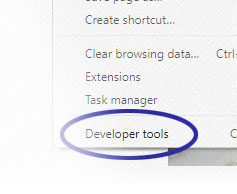Entries tagged "browser testing"
Trick Google Chrome Browser Window to Be Narrower Than 500 Pixels for Testing Responsive Designs

An issue I'm running into is that Google Chrome prevents its browser window from being narrower than 500 pixels. So I was using browsers, like Internet Explorer, to see how website designs adjust for small-screen devices. The problem is that I'm most familiar with the development tools available through Chrome. And there are times where it's easier to tweak the HTML and CSS code directly in Chrome versus going back to my normal code editor, editing the code, uploading the modified script, and then testing the changes. It turns out that there are a couple of options for addressing the issue. [Continue reading]
My Preference for Internet Explorer and Why That’s Changing
Now that we're all gathered, it's time to confess. Until recently, my browser of choice has been Internet Explorer (IE). Even though other browsers have come along with better standards support and great add-ons like the Web Developer Toolbar for Firefox, I've found myself straying back to IE. Since the official release of IE9, however, my preference has been changing. [Continue reading]
Using Google Analytics to Determine Which Browsers Are Used Most for Accessing Your Website
When designing websites, it's important to have a general idea of which browsers your audience prefers. Knowing this helps identify which browsers to use for testing your website. Some coding solutions may also need to be altered. For example, if 60% of visitors are still using Internet Explorer 6, you might need to rethink some of those fancy CSS techniques. So let's look into utilizing Google Analytics to figure out which browsers are being used. [Continue reading]
Using Internet Explorer 9 to Test Websites with IE8 and IE7
Did you know that Internet Explorer 9 (IE9) provides the capability for viewing websites in IE8 and IE7? There's no need to install an add-on or download anything from a browser archive. The power to test websites using all three versions of Internet Explorer is built in. Of course, the feature for switching between the different options is a little buried. [Continue reading]
Checking Multiple Browsers Before Responding to Website Support Requests
When responding to support requests involving a website it's important to remember that the customer may not be using the same browser as you. They may not even use the same operating system (Windows, Macintosh, etc.) There are many issues that I've seen over the years as a website developer which work perfectly fine in one browser and completely fall apart in another. So make sure that you have covered your bases before responding to the customer. [Continue reading]

